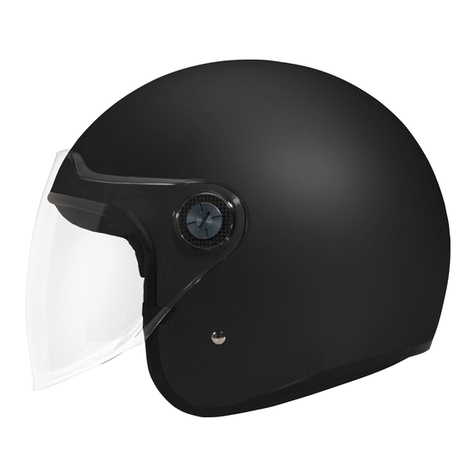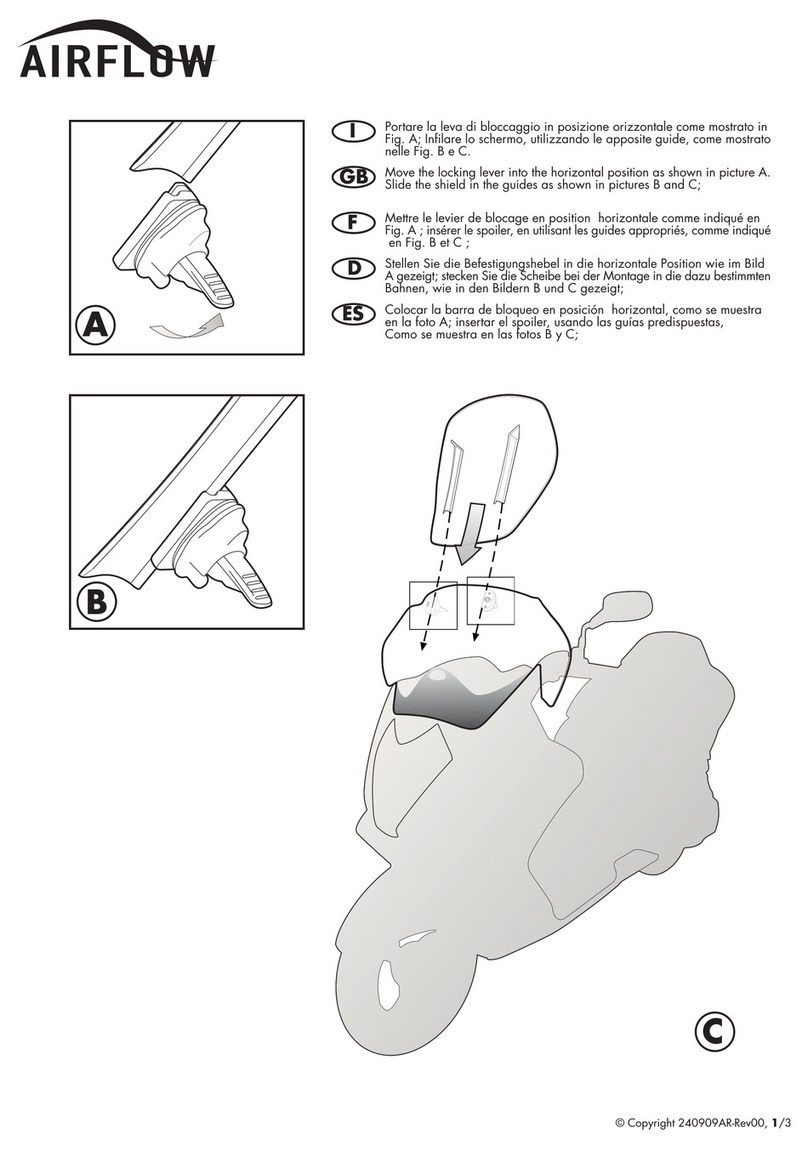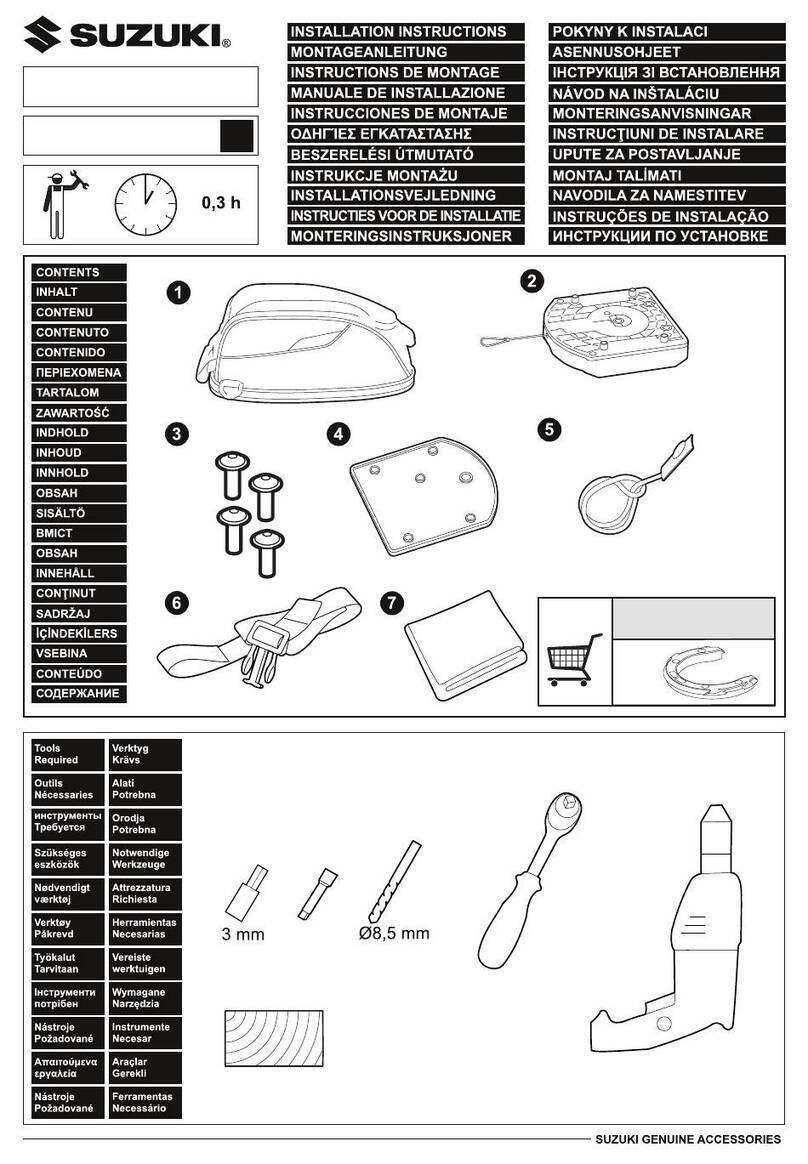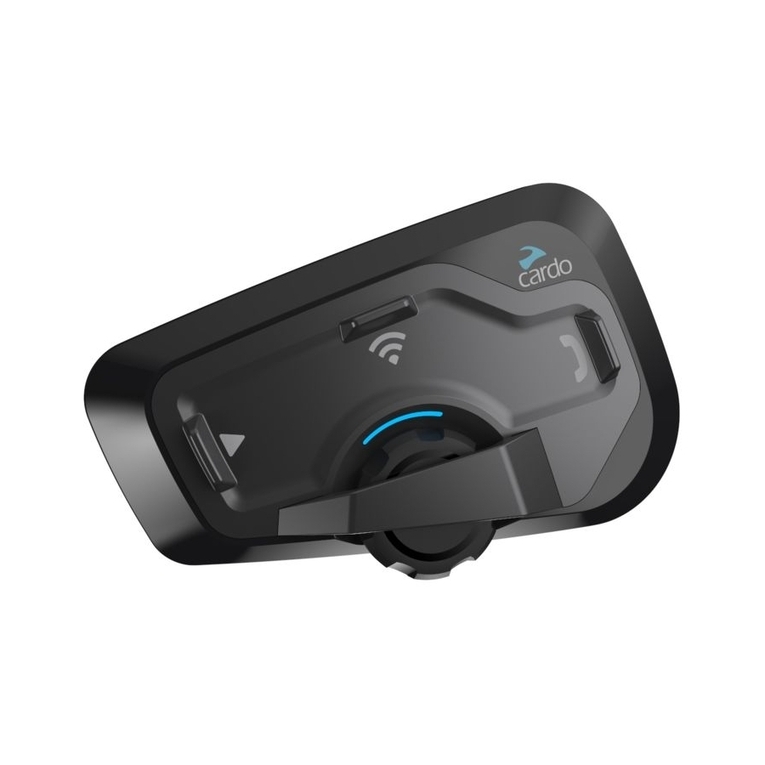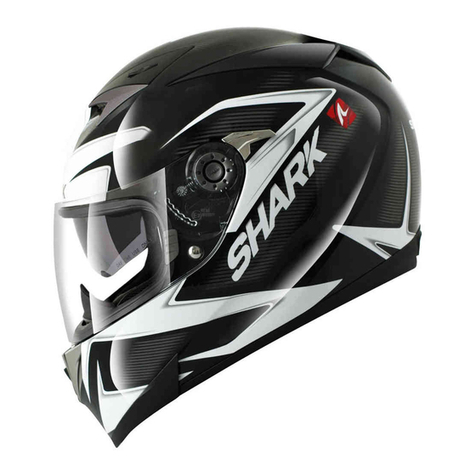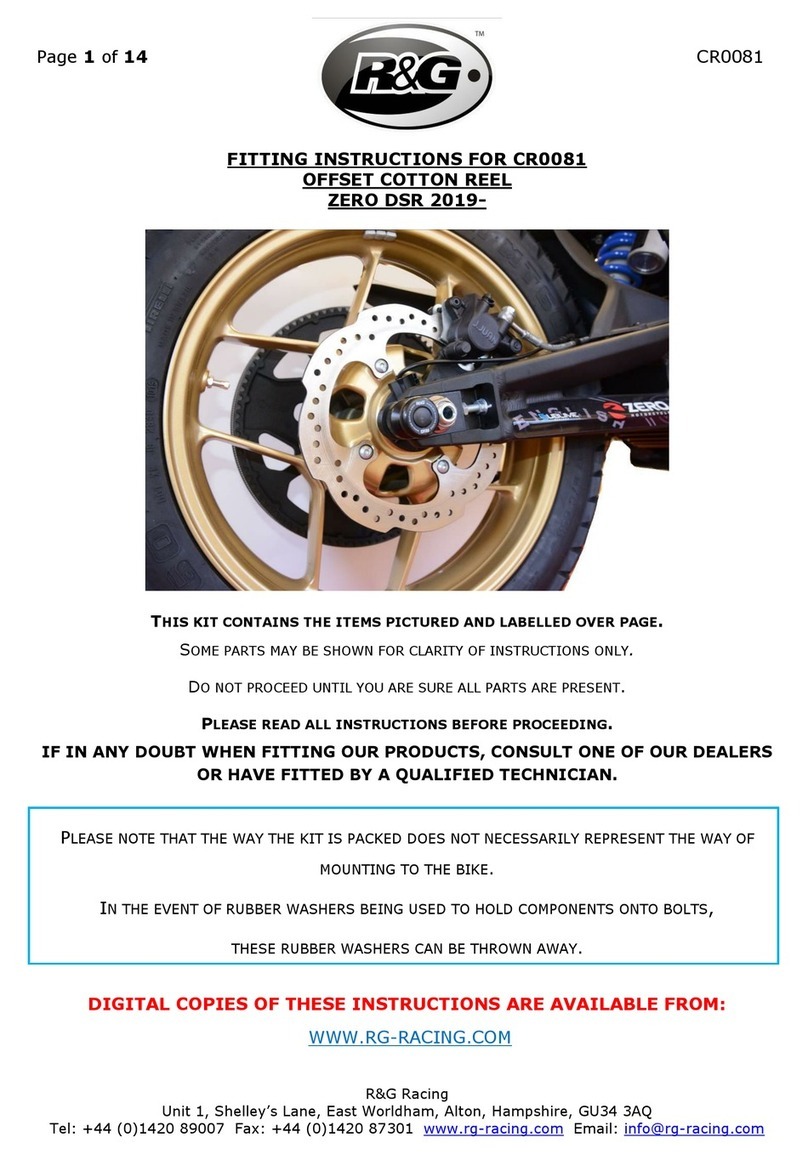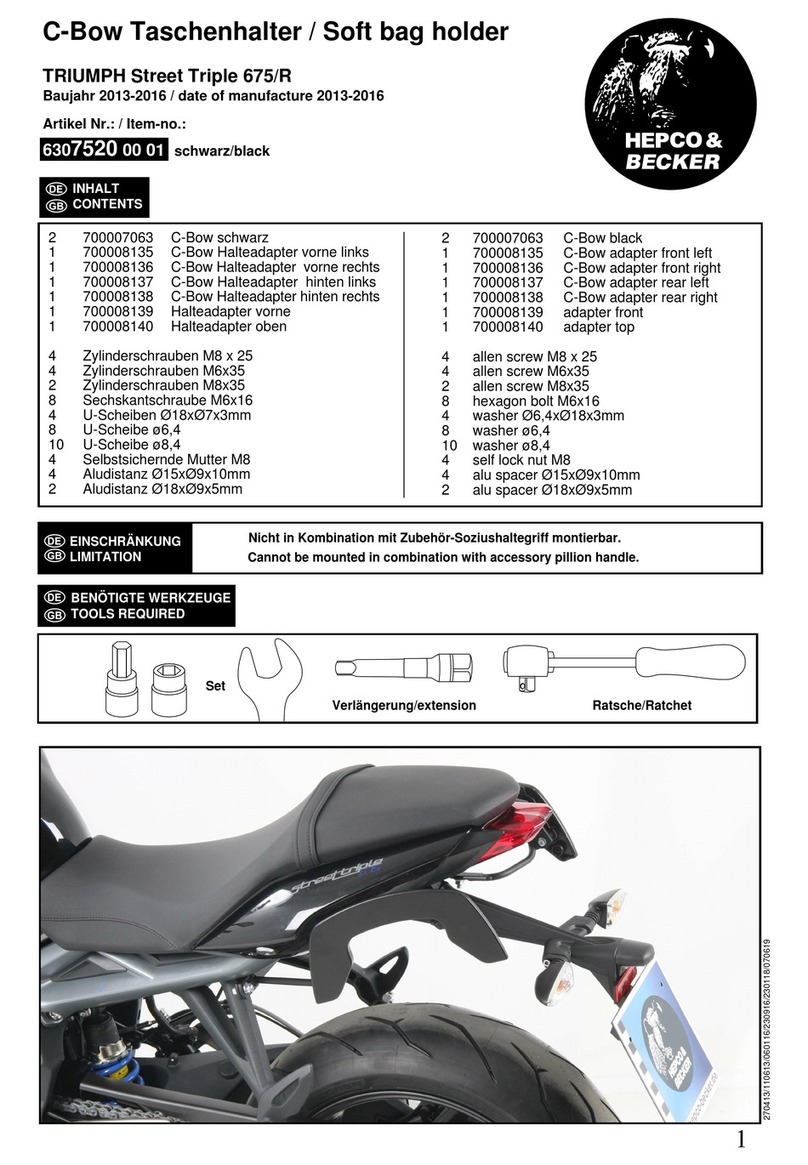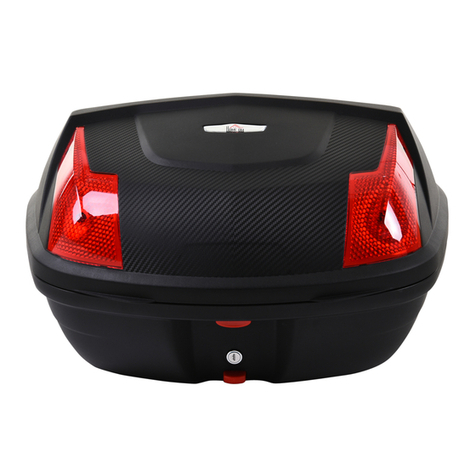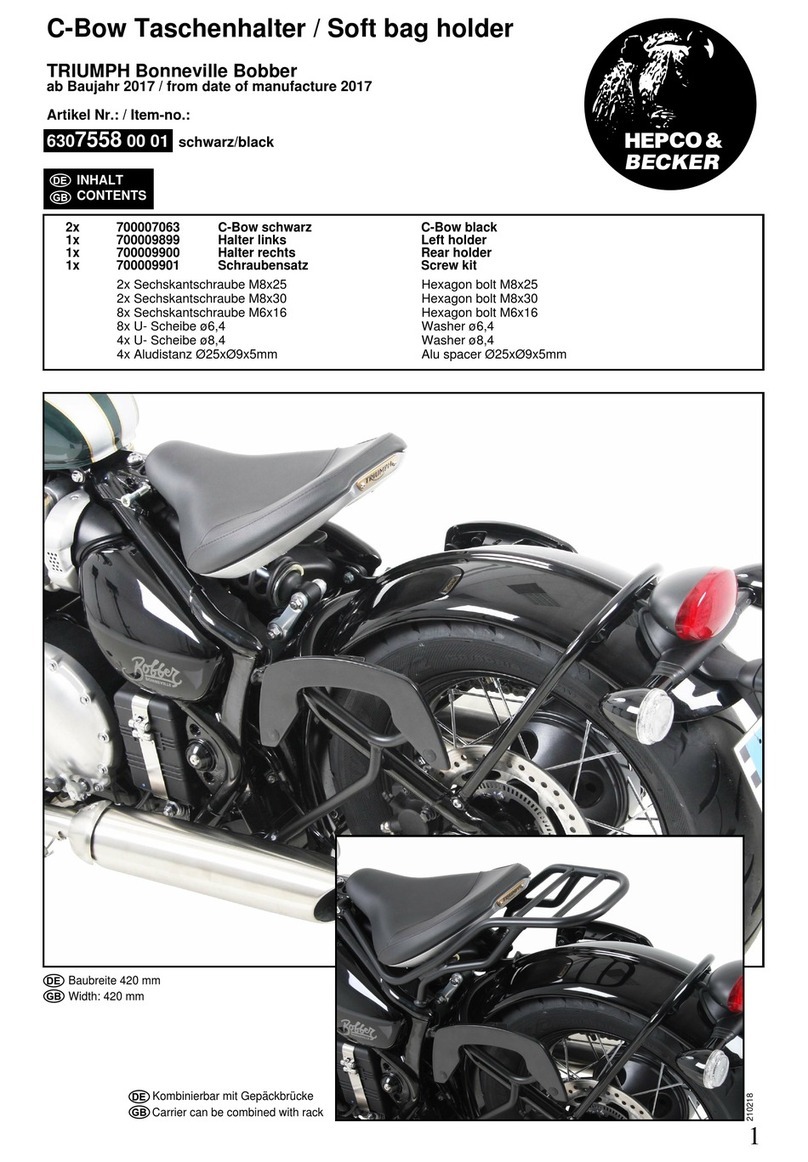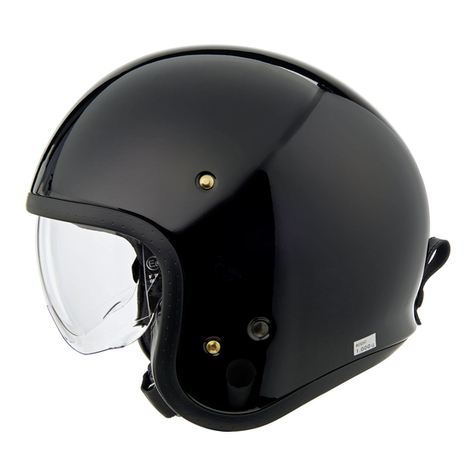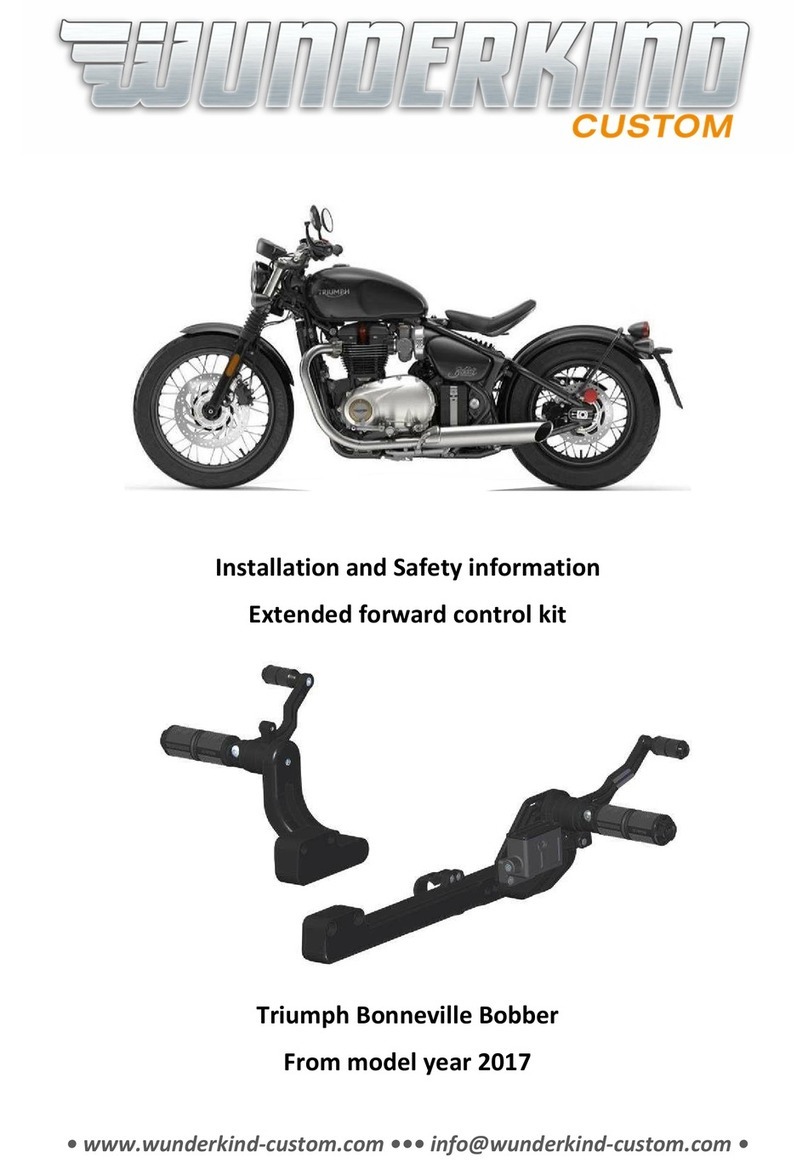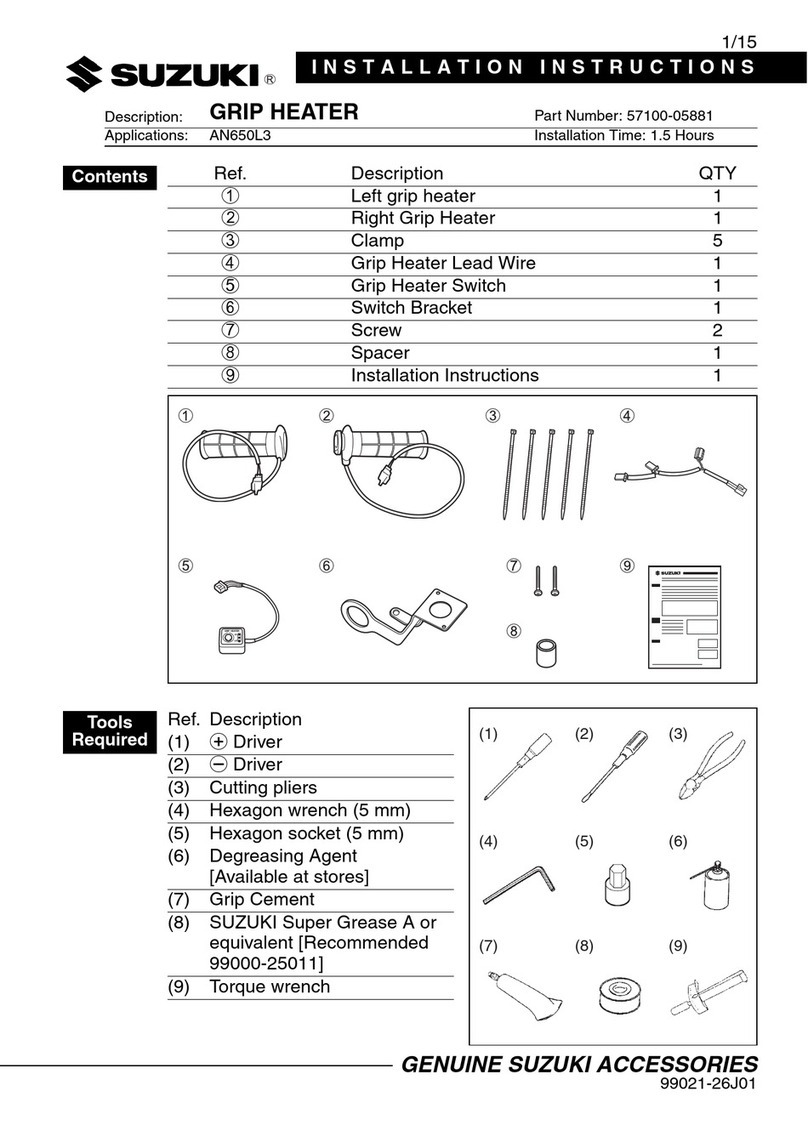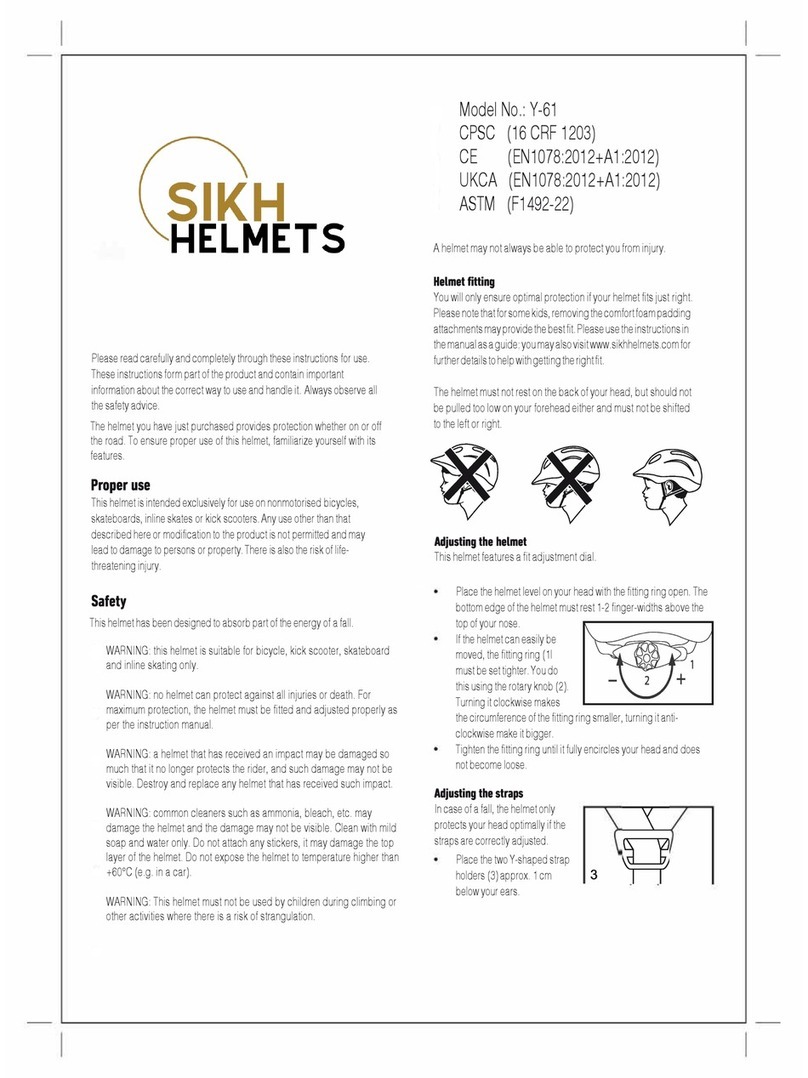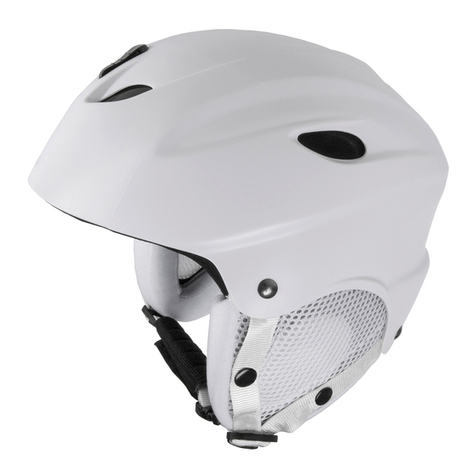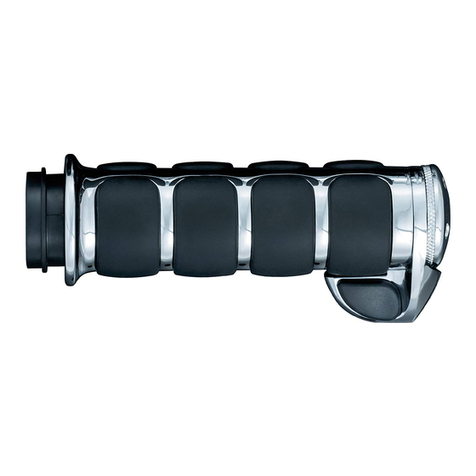NIOSH rpb NOVA 2000 User manual

INSTRUCTION
MANUAL

2
NIOSH CAUTIONS & LIMITATIONS 3
INTRODUCTION 4
RESPIRATORY COMPONENT CONCEPT 5
WARNINGS 6
RESPIRATOR OPERATION 8
SPECIAL OR CRITICAL USERS INSTRUCTIONS BREATHING AIR PRESSURE TABLE 10
SETUP 11
RESPIRATOR USE 12
INSPECTION, CLEANING AND STORAGE 15
PARTS AND ACCESSORIES 17
CONTENTS
Read all instructions and warnings before using this product.
Keep this manual for future reference.
RPB Safety Global Headquarters 2807 Samoset Rd, Royal Oak, MI 48073, USA.
T: 1-866-494-4599 F: 1-866-494-4509 E: sales.us@rpbsafety.com www.rpbsafety.com
RPB Safety Asia Pacic Headquarters 652 Halswell Junction Road, Hornby South 8042
New Zealand. T: +64-3-357-1761 F: +64-3-357-1763 E: sales.nz@rpbsafety.com
www.rpbsafety.com
RPB, advancing your safety and NOVA 2000 are registered trademarks of RPB® Safety
For technical assistance contact our Customer Service Department
Rev: 6

3
1. PROTECTION
CF – Continuous Flow SA – Supplied Air SB – Supplied Air ABrasive Blast
2. CAUTIONS AND LIMITATIONS
A - Not for use in atmospheres containing less than 19.5% oxygen.
B - Not for use in atmospheres immediately dangerous to life or health.
C - Do not exceed maximum use concentrations established by regulatory standards.
D - Air-line respirators can be used only when the respirators are supplied with respirable air meeting the
requirements of CGA G-7.1 Grade D or higher quality.
E - Use only the pressure ranges and hose lengths specied in the User’s Instructions.
J - Failure to use and maintain this product properly could result in injury or death.
M - All approved respirators shall be selected, tted, used and maintained in accordance with MSHA, OSHA,
and other applicable regulations.
N - Never substitute, modify, and, or omit parts. Use only exact replacement parts in the conguration
specied by the manufacturer.
O - Refer to user instruction and/or maintenance manuals for information about use and maintenance of
these respirators.
S - Special or critical User’s Instructions and/or specic use limitations apply. Refer to User’s Instructions
before donning.
RPB Safety
T. 1 866 494 4599 F. 1 866 494 4509 E. info@rpbsafety.com
TYPE CE, CONTINUOUS FLOW, SUPPLIED-AIR RESPIRATOR
THESE RESPIRATORS ARE APPROVED ONLY IN THE FOLLOWING CONFIGURATIONS
National Institute for
Occupational Safety and Health
D
E
P
A
R
T
M
E
N
T
O
F
H
E
A
L
T
H
&
H
U
M
A
N
S
E
R
V
I
C
E
S
•
U
S
A
NV2001
NV2016
4000-01
2015
4000-20
03-501
NV2002
NV2002L
NV2002XL
NV2002HBXL
NV2002HBXXL
NV2025
NV2024
NV2032
2034
2037
NV2027
NV2028
NV2029
2035
2036
NV2021
NV2004
NV2018
NV2031
NV2017
09-800
09-900
19C-363S A/CF/SB NOVA
2000
X
ABCDEJMNOS
19C-422S A/CF/SB NOVA
2000 ABCDEJMNOS
Protection1
RESPIRATOR COMPONENTS
Alternate
Helmets
Alternate
Capes
Alter
nate
Viso
r
Alternate
Lenses
Accessories
TC -
Breathing
Air Tube
Cautions
and Limitations2
M
O
D
E
L
Alternate Flow
Regulator
and Belt
Alternate Quick
Disconnect Alternate Hoses
X
X
X X
X
X X
X
X
X
X X X
X X X
XXX
X X
XXX
X X
X
X
X
X
XXXXX
XXXXX
S
S
NV
NV
NV
NV

4
INTRODUCTION
The RPB® NOVA 2000 SUPPLIED - AIR
RESPIRATOR TYPE CE is specically
designed for use during Abrasive Blasting.
The RPB® NOVA 2000 has been designed
for use in atmospheres NOT IMMEDIATELY
DANGEROUS TO LIFE OR HEALTH, and from
which a user can escape without the aid
of the respirator, or that do not exceed
concentrations allowed by OSHA, EPA and
NIOSH regulations and recommendations.
The RPB® NOVA 2000 is Approved by NIOSH
(TC-19C-363, 19C-422-TYPE CE) to provide
respiratory protection in abrasive blasting
and type CE painting applications. The cape
is designed to protect the wearer’s upper
body from rebounding abrasive.
The RPB® NOVA 2000 is NIOSH Approved
for use with the NV2015, NV2016, 4000-01
Cold Air Tube, 4000-20 Hot Air Tube, and
the 03-501 Climate Control Assembly.

5
RESPIRATOR COMPONENT CONCEPT
The RPB® NOVA 2000 SUPPLIED AIR RESPIRATOR consists of three main components:
RESPIRATOR HELMET ASSEMBLY, BREATHING TUBE ASSEMBLY, and AIR SUPPLY HOSE. All three
components must be present and properly assembled to constitute a complete NIOSH approved
Respirator.
!WARNING! Failure to use genuine parts and components that are part of the NIOSH
approved respirator assembly will void the approval of the entire respirator assembly.
1. Respirator Helmet Assembly
2. Breathing Tube Assembly
3. Air Supply Hose
Cape
Inner & Outer Lenses
Figure 1.1

6
1. Do not use this respirator until you
have been trained in the respirators
use, maintenance and limitations by
a qualied individual (appointed by
your employer) who has extensive
knowledge of the RPB® Nova 2000
Respirator.
2. Before using this respirator ensure your
employer has determined that airborne
contaminant concentrations do not
exceed those allowed by applicable
OSHA, EPA or NIOSH regulations and
recommendations for continuous-ow
supplied air respirators. Federal law
requires that the employer measures
and monitors airborne contaminant
levels in the work area.
3. DO NOT WEAR this respirator if any of
the following conditions exist:
- Atmosphere is immediately dangerous
to your life or health.
- You CAN NOT escape without the aid
of the respirator.
-Atmosphere contains less than 19.5%
oxygen
- Work area is poorly ventilated
- Contaminants are in excess of
regulations or recommendations
!WARNINGS!
4. Do not modify or alter this respirator.
Use only NIOSH approved RPB® NOVA
2000 components and replacement
parts. The use of non approved parts
voids the NIOSH approval of the entire
respirator assembly.
5. Inspect all components of the respirator
daily for signs of damage or wear
and tear that may reduce the level of
protection originally provided.
6. Do not use abrasives containing silica,
lead, arsenic or sharp glass particles
- use of abrasives containing these
elements could result in serious injury
or death.
7. Do not wear this respirator until you
have passed a complete physical exam
including a lung X-ray conducted by
qualied medical personnel.
8. Improper use of this respirator may
cause injury or death. Improper
use may also cause life threatening
delayed lung diseases such as silicosis,
pneumoconiosis or asbestosis.

7
9. This respirator, when properly tted and
used, signicantly reduces but does not
completely eliminate the breathing of
contaminates by the respirator wearer.
10. Be certain your employer has
determined that the breathing air
source provides at least Grade D
breathable air. The respirator must be
supplied with clean breathable air at all
times.
11. Do not connect the respirator’s air
supply hose to nitrogen, toxic gases,
inert gases or other unbreathable
non Grade D air sources. Check the air
source before using the respirator. This
apparatus is not designed for use with
mobile air supply systems i.e. cylinders.
Failure to connect the supply hose to
the proper air source could result in
serious injury or death.
12. DO NOT use this respirator in poorly
ventilated areas or conned spaces.
Ensure the area is well ventilated and
that the contaminant concentrations
are below those recommended for this
respirator. Follow all procedures for
conned space entry, operation and
exit as dened in applicable regulations
and standards.
13. LEAVE WORK AREA IMMEDIATELY IF:
- Any respirator component becomes
damaged.
- Airow stops or slows down.
- Breathing becomes dicult.
- You become dizzy, nauseous, too hot,
too cold or ill.
- Vision is impaired.

8
RESPIRATOR OPERATION
AIR QUALITY
This respirator must be supplied with clean
breathable air, Grade D or better, at all times.
The RPB® NOVA 2000 does not purify air or
lter contaminants. Breathable air must be
supplied to the point of attachment of the
RPB® NOVA 2000 air supply hose.
Supplied breathing air must at least meet
the requirements for Type 1 gaseous
air described in the Compressed Gas
Association Commodity Specications G.7.1
(Grade D or higher).
AIR SOURCE
Locate the air source in a clean air
environment, always use a lter on the inlet
of your air source. Do not park vehicles
beside your air inlet as this will cause carbon
monoxide to be drawn into your air supply.
Use suitable aftercoolers / dryers with lters
and carbon monoxide alarms to assure clean
breathable air is supplied at all times.
The air should be regularly sampled to
ensure that it meets Grade D requirements.
BREATHING AIR PRESSURE
The air pressure must be continually
monitored at the point of attachment
while the air is owing to the respirator.
Air pressure must be read from a reliable
pressure gauge whilst the respirator has air
owing through it.
!WARNING! Failure to supply the respirator
with the minimum required pressure at
the point of attachment for the length
of air supply hose used could result in
contaminants being inhaled as the pressure
in the helmet may become negative due to
peak inhalation ow when working at very
high work rates.
The RPB® NOVA 2000 BREATHING AIR
PRESSURE TABLE on Page 10 denes the
air pressure ranges needed to provide the
respirator with a volume of air which falls in
the required range of 6 - 15 cfm or 170 - 425
lpm.
BREATHING AIR SUPPLY HOSE AND
FITTINGS
NIOSH approved RPB® NOVA 2000 air supply
hoses must be used between the point of
attachment and the respirator breathing air
connection at the wearer’s belt. RPB® NOVA
2000 quick disconnect ttings must be used
to connect the hose lengths together. The
hose sections must be within the approved
length and the amount of sections must be
within the number specied in the Breathing
Air Pressure Table.

9
!WARNING! Make sure you understand the
Breathing Air Pressure Table before using
this respirator.
1. Determine your air source (column 1)
2. Find your breathing tube assembly
(column 2)
3. Be sure your air supply hose is RPB®
Safety NOVA 2000 breathing air hose.
4. Check your RPB® Safety air supply hose is
within the approved length in column 4.
5. Set the air pressure at the point of
attachment within the range specied
in column 6 for your breathing tube
assembly, hose length and amount of
hose sections. Make sure air is owing
through your respirator when setting
the pressure.

10
1.
AIR SOURCE
2.
BREATHING TUBE
ASSEMBLY AND
FLOW CONTROL
DEVICES
3.
AIR SUPPLY
HOSE
4.
SUPPLY
HOSE
LENGTH
5.
MAX
NUMBER
OF SECTIONS
6.
PRESSURE
RANGE
PSIG AIR
Portable or
Stationary
Compressor
NV2021/
NV2016
Flow Control
Valve Assembly
NV2027(100ft)
NV2028(25ft)
NV2029 (50ft)
25
50
100
150
200
250
300
1
2
2
3
4
5
6
28 - 30
28 - 30
30 - 33
33 - 36
36 - 38
38 - 39
39 - 43
Low Pressure
Compressor
or Air Pump
NV2021/
NV2015
Constant Flow
Valve Assembly
NV2035 (50ft)
NV2036 (100ft)
50
100
150
200
250
300
1
1
2
2
3
3
7 - 8
8 - 9
10 - 11
11 - 12
12 - 13
14 - 15
Portable or
Stationary
Compressor
NV2021
03-501
Climate Control Tube
Assembly
NV2027 (100ft)
NV2028 (25ft)
NV2029 (50ft)
25
50
100
150
200
250
300
1
1
2
3
4
5
6
50 - 80
55 - 85
60 - 95
65 - 95
70 - 100
75 - 100
85 - 100
Portable or
Stationary
Compressor
NV2021B/
4000-01
Cold Air Tube
Assembly
NV2027 (100ft)
NV2028 (25ft)
NV2029 (50ft)
25
50
100
150
200
250
300
1
1
2
3
4
5
6
55 - 56
56 - 57
60 - 62
65 - 67
70 - 72
77 - 78
80 - 82
Portable or
Stationary
Compressor
NV2021B/
4000-20
Hot Air Tube
Assembly
NV2027 (100ft)
NV2028 (25ft)
NV2029 (50ft)
25
50
100
150
200
250
300
1
1
2
3
4
5
6
67 - 68
69 - 70
73 - 74
77 - 78
81 - 82
86 - 87
91 - 92
This table lists Air pressure ranges needed to provide the RPB® NOVA 2000 with the volume
of air that falls within the required range of 6 -15 cfm or 170 - 425 lts/min according to U.S.
government regulations.
BREATHING AIR PRESSURE TABLE
SPECIAL OR CRITICAL USERS INSTRUCTIONS
!WARNING! Respirators must be supplied with respirable air meeting the requirements
of CGA G-7.1 Grade D or Higher Quality.

11
SETUP
NOTE:
Check the hose connections for any air
leaks and tighten if necessary - replace any
worn parts.
With air owing through the respirator
adjust the air pressure at the point of
attachment to the recommended pressure
as specied in the Breathing Air Pressure
Table (page 10).
Connect the RPB® Safety NOVA 2000 Air
Supply Hose to a breathing air source
supplying Grade D or better quality air.
Connect the respirator quick disconnect
tting onto the Air Supply Hose.
Figure 2.1 Figure 2.2

12
RESPIRATOR USE
Optional tear-o lenses can be used with
the outer lens. It is recommended to use
2-3 tear-o lenses and an outer lens for
extra protection.
Fit an outer lens onto the tabs on the visor,
fold the visor onto the helmet and secure
it with latch, making sure there are no gaps
between the visor and the window frame
gasket.
LENSES
Figure 3.1
Figure 3.3
Figure 3.2
!WARNING! DO NOT use this respirator
without an inner lens in place.
Make sure you have an RPB Safety inner
lens securely tted into the window frame
gasket.

13
Blast Jackets (NV2002HB Series): Put your
arms through the arm holes then pull the
jacket down around your waist.
With air owing into your Respirator fold
back the cape, open the inner bib and place
your ngers on the inner bib and the side
of the helmet at approximately ear position,
lift the helmet and place onto your head.
Regular Capes: Pull the respirator cape
around your body and fasten the snap
hooks on each side of the cape.
Pull the inner bib around your neck and
adjust the elastic cord to ensure a snug
t around your neck - this helps provide a
barrier to airborne contaminants.
DONNING YOUR HELMET
Figure 3.4
Figure 3.6
Figure 3.5
Figure 3.7

14
RESPIRATOR USE CONTINUED
When attaching the breathing tube to
the helmet, attach the xed end of the
breathing tube hose to the helmet tting
and the loose running nut to the ow
control valve.
When you have nished working leave
the work area wearing the respirator with
air still owing into the helmet. Once
outside the contaminated area remove the
respirator and disconnect the air supply
hose.
!WARNING! NEVER remove your helmet
whilst in a contaminated area or where
blasting is still being performed, as this may
result in serious injury or death.
NOTE:
Re-check the air pressure and adjust
if necessary. With air owing into your
respirator you are now ready to enter the
work area.
Fasten the belt at waist or hip level and
adjust for comfort. Rotate the belt holder
until it is in the hip pocket area.
DOFFING YOUR HELMET
Figure 3.8 Figure 3.9

15
INSPECTION, CLEANING & STORAGE
The helmet linings can be removed and
sponged with warm water and a gentle
detergent, then air dried before retting
into the helmet.
HELMET AND LININGS
The helmet shell and window frame gasket
can be sponged with warm water and a
gentle detergent, rinsed and air dried.
NOTE:
The leather cape must be cleaned with an
approved leather cleaner.
Figure 4.1 Figure 4.2

16
BREATHING TUBE ASSEMBLY
Inspect the breathing tube for cracks or
excessive wear. Check that the ttings are
secured into the hose tightly and aren’t
allowing any air to escape.
Replace the hose as soon as signs of
damage or excessive wear become evident.
Do not remove the foam that is inside the
breathing tube as this helps reduce the
noise levels of the incoming air.
!WARNING! Air leaks will cause a drop
in air ow through the respirator
helmet resulting in less protection from
contaminants.
AIR SUPPLY HOSE
The air supply hoses should be inspected
for cuts, cracks, blisters and signs of
abrasion. Make sure the ttings are
tightly crimped to the hose so that air
cannot escape. Make sure the hose has
not been crushed or kinked. Replace the
hose immediately if there are any signs
of damage. Do not run water through
the inside of the hose. Check the Quick
Disconnect Couplings and blow down with
a duster gun to remove any sand or dirt
that may jam the coupler.
!WARNING! Use only the correct hoses by
for this respirator.
STORAGE
After the respirator components have been
cleaned and inspected place them in a
plastic bag or an airtight container. Store
respirator parts away from excessive heat,
dust, cold, moisture or harmful chemicals.
After use hang the respirator up by the
hand strap, this will help keep the inside of
the helmet free of contaminants.
INSPECTION, CLEANING & STORAGE CONTINUED

17
Visor & Lenses - Figure 5.2
Padding System - Figure 5.1
Air Supply Hoses - Figure 5.3
Respirator Capes - Figure 5.5
Breathing Tube &
Flow Control Devices - Figure 5.4
PARTS AND ACCESSORIES
NV2009 Polystyrene Helmet Liner (Sizes S, M & L) NV2010 Sidewings (Sizes S, M & L)
PADDING SYSTEM Figure 5.1
NV2009 NV2010

18
PARTS AND ACCESSORIES CONTINUED
NV2003 Window Frame Gasket
NV2004 Visor with Hinge and Screws
NV2017 Tearo Lens Packet 50
NV2018 Inner Lens Packet 10
NV2031 Outer Lens Packet 50
NV2008 Latch
AIR SUPPLY HOSES Figure 5.3
VISOR AND LENSES Figure 5.2
NV2004
NV2031
NV2018
NV2017
NV2003
NV2008
NV2027 100ft Air Supply Hose
NV2028 25ft Air Supply Hose
NV2029 50ft Air Supply Hose
NV2025 Quick Release Coupler
NV2035 50ft Low Pressure Air Supply Hose
NV2036 100ft Low Pressure Air Supply Hose
NV2025
NV2028
NV2029 NV2027
NV2035
NV2036

19
BREATHING TUBE & FLOW CONTROL DEVICES Figure 5.4
RESPIRATOR CAPES Figure 5.5
NV2002 28¨ Nylon Cape
NV2002XL 38¨ Nylon Cape
NV2002L 28¨ Leather Cape
NV2002HB-XL Blast Jacket Size XL
NV2002HB-XXL Blast Jacket Size XXL
NV2012 Inner Bib
NV2012
NV2002HB-XXL
NV2002HB-XL
NV2002L
NV2002XL
NV2002
NV2021 Breathing Tube
NV2022 Belt
NV2016 Flow Control Valve Assembly - Includes: Flow Control Valve, Belt
NV2015 Constant Flow Valve - Low Pressure
4000-01 Cool Air Tube Assembly - Includes: Cool Air Tube, Belt
4000-20 Hot Air Tube Assembly - Includes: Hot Air Tube, Belt
03-501 Climate Control Assembly - Includes: 03-501, Belt
NV2016
4000-01
03-501
NV2022
4000-20
NV2021
NV2015

AIRLINE FILTRATION
The RPB®RADEX AIRLINE FILTER™ oers
increased capacity, versatility and ltration.
This optional equipment combines the
versatility of either oor or wall mounting
with increased ltration capacity, enabling
customization to meet worker’s needs and
working environments.
AIR TEMPERATURE CONTROL
The RPB®4000-01 Cool Air Tube cools
compressed breathing air coming into
the respirator by up to 30°F while the
RPB®4000-20 Hot Air Tube will heat the
compressed air by up to 30°F. These
maximize worker comfort and increase
productivity in hot or cold climates.
AIR QUALITY MONITORING
The RPB®RADEX CO MONITOR™ helps
ensure worker safety with a unique
traceability feature that monitors and
records carbon monoxide levels, and
temperature. This data that provides
certainty of monitor functioning and can
be stored for up to two years allowing
analysis of plant and eld air quality.
1866 494 4599
www.rpbsafety.com
OTHER PRODUCTS
Table of contents

